These Mini Sourdough Oatmeal Blueberry Egg Bagels are chewy on the outside with a hit of tanginess due to the sourdough.
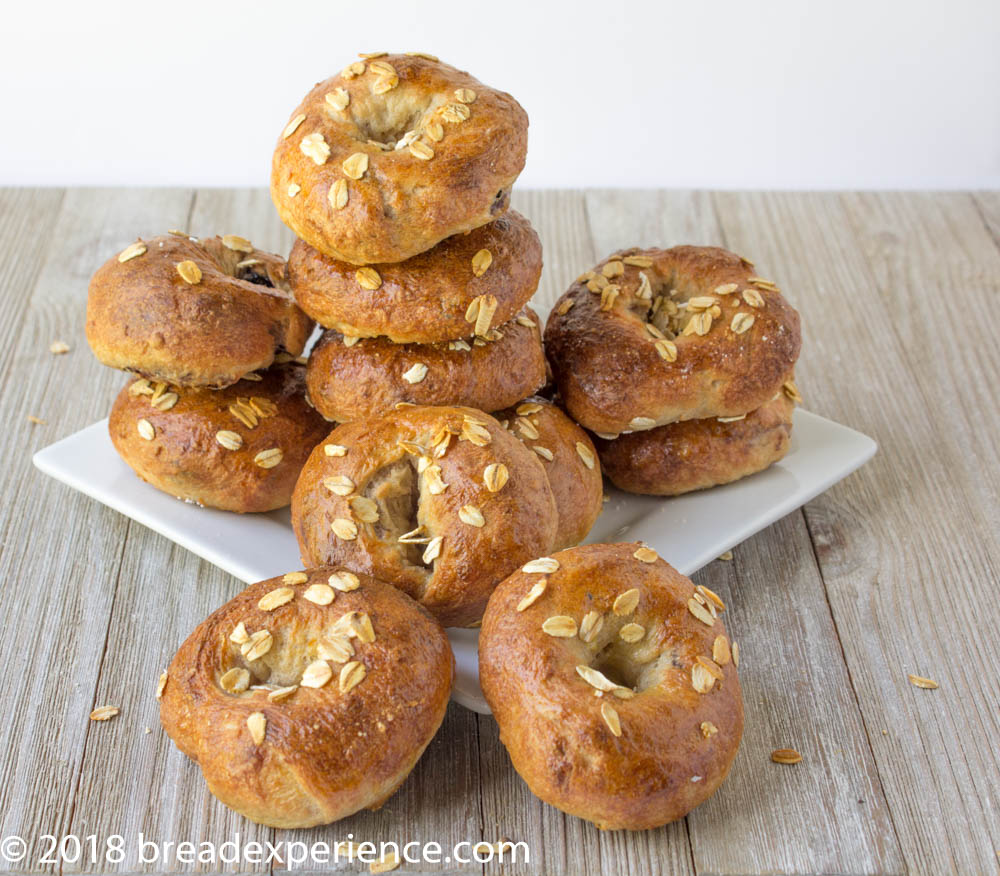
For the past couple of months, I’ve been playing around with a method that’s been working well so I decided to try it with these bagels. The method I’m referring to is using an overnight Pate Fermentee to provide flavor and structure to the final dough.
I’ve always loved using the Pate Fermentee technique, but what I’ve been doing recently, is instead of using a pinch of yeast to start the process and then adding more yeast to the final dough, I’ve been adding 25 grams of sourdough to the Pate Fermentee and using that as the only source of fermentation. So far, my experiments have worked well.
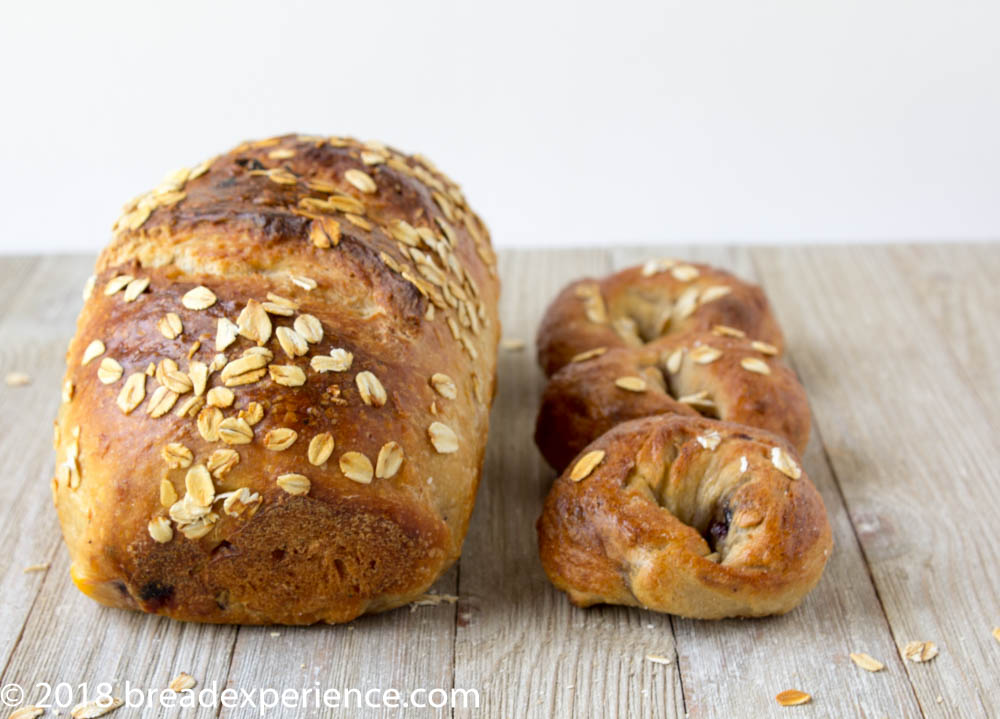
I started the Pate Fermentee for the sourdough oatmeal blueberry egg bagels late Thursday evening and mixed the final dough about 18 hours later. The preferment was nicely developed by the time I mixed the final dough Friday evening after work.
After the final mix, the dough rested on the counter for a few hours but still wasn’t developed so I gave it a cold ferment in the refrigerator overnight. I finished baking the bagels Saturday morning and enjoyed them for a late-morning snack.
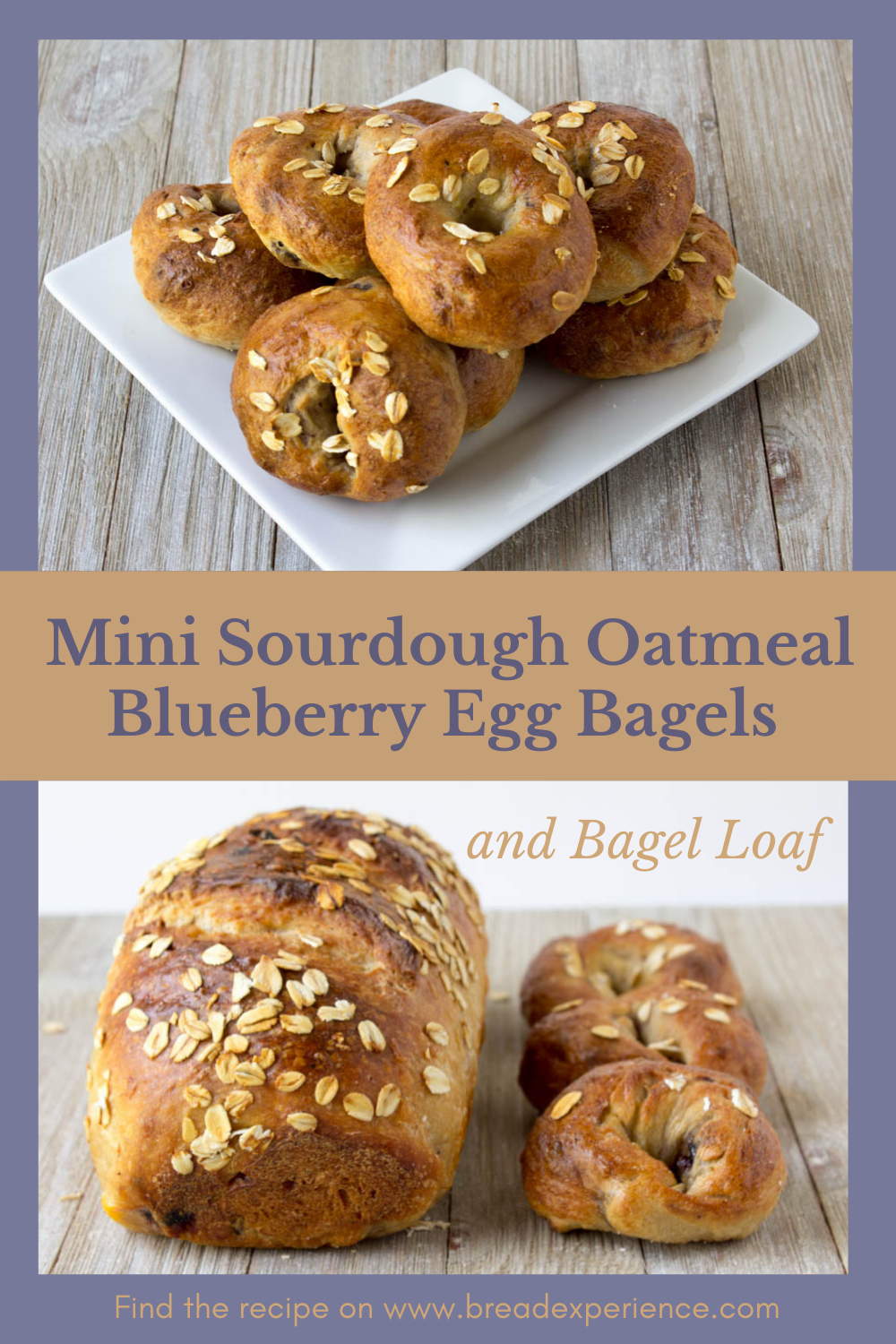
Along with the sourdough, these bagels also include eggs, potato water, 125 grams (13%) emmer flour, and 100 grams (11%) rolled oats.
The addition of the oats and whole grain flour made for a heavier dough so I think the Pate Fermentee along with the eggs helped give the bagels the lift they needed.
Print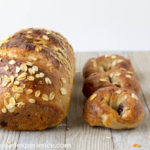
Mini Sourdough Oatmeal Blueberry Egg Bagels and Bagel Loaf
- Yield: 30 mini bagels or 2 9x5-inch loaves 1x
Description
These Mini Sourdough Oatmeal Blueberry Egg Bagels are chewy on the outside with a hit of tanginess due to the sourdough.
Ingredients
Potato Water:
- 1 or 2 large russet potatoes (about 3/4 lbs/340 grams) (only the potato water is used)
- 500 grams (2 1/2 cups) water *
* After boiling the potatoes, you should have about 2 cups of potato water.
Pate Fermentee:
- 272 grams (2 1/8 cups) bread flour
- 180 grams (3/4 cup) potato water (reserve the rest of the water for the final dough)
- 5 grams (1 tsp) salt
- 25 grams sourdough starter, active
Final Dough:
- 450 grams (3 1/2 cups) all-purpose flour
- 125 grams (1 cup) whole grain emmer flour
- 100 grams (1 cup) rolled oats
- 15 grams (3 tsp) salt
- 250 grams (1 cup) water (more or less, as needed)
- 45 – 68 grams (2-3 Tbsp) honey, as desired
- 56 grams (1/4 cup) corn oil
- 4 large eggs (200 grams)
- 75 – 100 grams dried blueberries
Egg Glaze:
- 1 egg beaten with 1 Tbsp water
- Oats or seeds for garnish
For boiling the bagels:
- 3–4 quarts water
- 1 1/2 tablespoons barley malt powder
- 1 tablespoon baking soda
- 5–10 grams (1-2 tsp) salt
Instructions
Evening Day 1:
Prepare the Potato Water
Peel potatoes and cut into large chunks, boil in 2.1/2 cups water until tender.
Drain but reserve 2 cups of the potato water. Let cool until lukewarm. Use the potato for other purposes.
Start the Pate Fermentee
Add all of the ingredients in a medium bowl and mix using a wooden spoon or Danish dough whisk until just smooth. Allow the preferment to sit at room temperature for 14-18 hours, depending on the temperature in your kitchen.
Afternoon or Evening Day 2:
In a large bowl using a Danish dough whisk or the work bowl of a heavy-duty electric mixer fitted with the paddle attachment combine 250 grams (2 cups) AP flour, all of the emmer flour, oats, and salt.
Add potato water, honey, and oil. Beat on medium speed for 2 minutes. Add 100 grams of the AP flour and the eggs and beat again for 2 minutes.
Add the remaining flour, 50 grams at a time, until a soft dough forms that just clears the side of the bowl. Switch from the paddle to the dough hook and knead for 2-3 minutes, or until the dough is smooth and springy.
Add in the dried blueberries gradually until thoroughly mixed in the dough.
Switch to using your hands and a bowl scraper when necessary, if mixing by hand. Turn the dough out on a lightly floured surface and knead in the dried blueberries until evenly dispersed throughout the dough.
Let the dough rest for 30 minutes. Then complete a couple of folds and turns. Only dust with flour to prevent sticking.
Place dough in a deep container. Cover with a kitchen towel or plastic wrap and let rise for 2-3 hours.
Cover tightly and place the bowl in the refrigerator. Allow the dough to cold ferment in the refrigerator overnight, 8-12 hours.
Morning Day 3:
Remove the dough from the refrigerator and allow it to warm up to room temperature for 2-3 hours, depending on the temperature in your kitchen.
To form the egg bagels:
Gently deflate the dough. Turn out onto a lightly floured surface and divide into quarters. Then each quarter into 6-8 equal portions. I shaped mine into 16 balls (~64 grams each) and used the remaining 700 grams for the bagel loaf.
Shape each portion into a smooth round. Flatten with your palm and poke a floured finger through the middle of the ball. Stretch the hole with your finger to make it about 1 inch in diameter. Spin the dough around your finger. The hole will shrink slightly when you stop.
Alternately, roll the ball out into a log and wrap around your hand. Press the ends together securely.
Form all bagels. They will need no further rise at this point.
20 minutes before baking, preheat the oven to 425°F (220°C). Grease or parchment line 2 baking sheets. Meanwhile, bring a large pot (3-4 quarts) of water to a boil. Add 1 Tbsp baking soda, 1.1/2 Tbsp barley malt powder, and 1 tsp or more of salt to the boiling water. Reduce the heat to maintain a gentle low boil.
With a slotted spatula, lower 3-4 bagels at a time into the gently boiling water. They will drop to the bottom and then rise to the surface. As they come to the surface, turn each bagel and boil it for 3 minutes on the other side. This goes very quickly, if you are making the entire batch of bagels, use a second pot of boiling water.
Remove the bagels from the boiling water with a slotted spoon and place each 1 inch apart on the baking sheets. When all the bagels have been boiled, brush with the glaze and sprinkle with the seeds if desired. Place the baking sheet in the oven and bake for 25-30 minutes (less if making mini bagels like I did) or until deep golden. Transfer the bagels immediately to a cooling rack.
To form and bake the bagel loaf:
In step 5 turn the dough out onto a lightly floured surface and divide into 3 equal portions. Form into a loaf and place in 3 greased 8.5-inch loaf pan.
Cover loosely with plastic wrap or a kitchen towel and let rise at room temperature until just level with the tops of the pans. (These loaves will rise a lot in the oven) about 40 minutes.
20 minutes before baking preheat the oven to 375°F (190°C)
Brush the tops with egg glaze and using kitchen shears, or a lame (pronounced lahm) carefully snip the top of the dough about ½” deep at 2” intervals down the center of the loaf.
Bake in the center of the preheated oven until crusty, golden brown, and the top sounds hollow when tapped with your finger, 40-45 minutes. Transfer the loaves to a cooling rack. Cool completely before slicing.
Notes
Inspired and adapted from the following methods:
Egg Bagels from The Bread Bible: 300 Favorite Recipes by Beth Hensberger
Roasted Potato Bread from Bread by Jeffrey Hammelman
- Category: Bagels
- Method: Sourdough
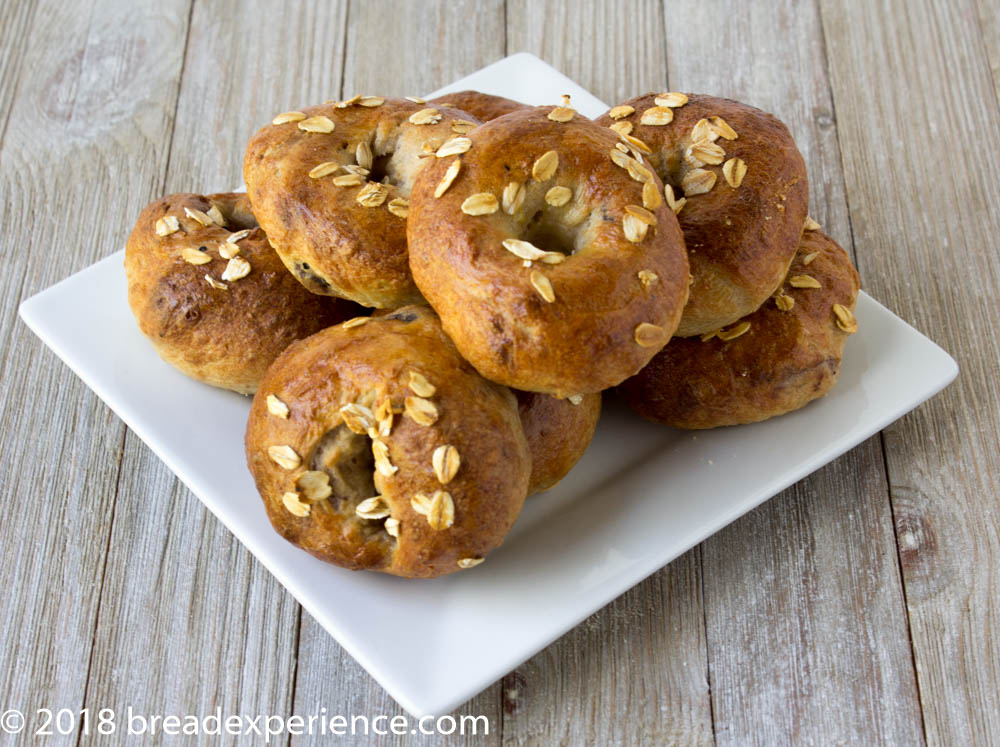
Egg bagels are the featured bread of the month for November for the Bread Baking Babes, and as usual, I couldn’t leave well enough alone. I took the pieces of the recipe I liked and changed the rest to suit my fancy. Fortunately, I was pleased with the results.
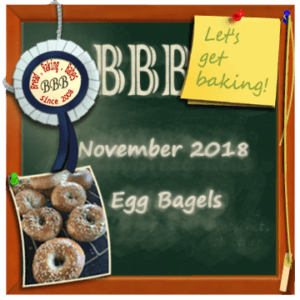
If you’d like to bake with us this month, check out Karen Bakingsoda’s post for information on how to participate in the monthly bake.
Check out the other Bread Baking Babes’ take on these bagels:
- Bake My Day – Karen Bakingsoda
- Karen’s Kitchen Stories – Karen
- Blog from OUR Kitchen – Elizabeth
- A Messy Kitchen – Kelly
- Judy’s Gross Eats – Judy
- My Kitchen in Half Cups – Tanna
- Feeding My Enthusiasms – Elle
- Bread Experience – Cathy
Happy Baking!
Cathy
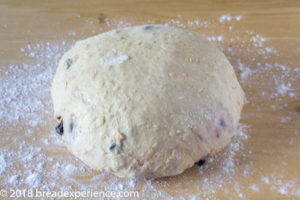
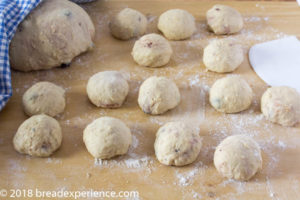
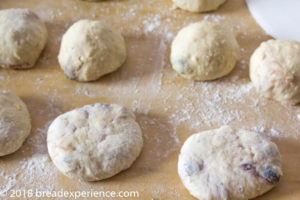
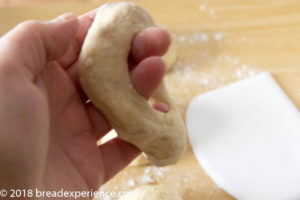
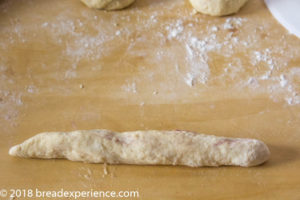
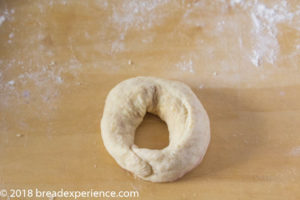
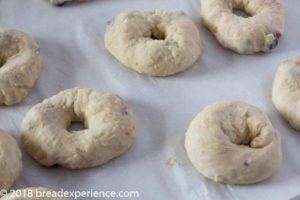
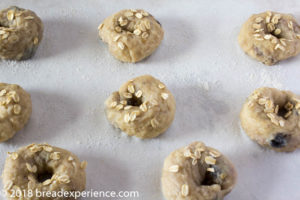
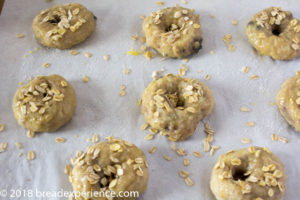
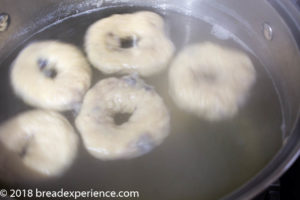

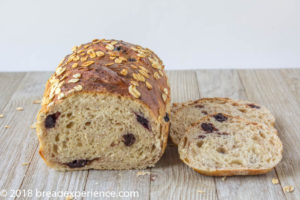
Karen says
These are really cute! The crumb on the loaf looks fabulous too.
Cathy says
Thanks Karen! I didn’t set out to make mini bagels, but I’m pleased with the way they turned out.
Kelly says
Love the sourdough technique and that cross section of the bagel loaf is just beautiful! Love how your bagels turned out!
Cathy says
Thank you Kelly! I quite like the bagel loaf. It has a very interesting texture.
Elizabeth says
I’m really glad you made these without commercial yeast. I was a little afraid to do so; the last time I did that, the bagels were not very lofty. How wonderful that your bagels turned out so fabulously! I wonder if it was the presence of the eggs or the potato water that caused them to puff up so well.
Cathy says
Thanks Elizabeth! I’m glad I made them with wild yeast as well. Since my egg bagels contain a portion of oats and whole grain emmer flour in addition to the all-purpose flour, they aren’t as lofty as ones made completely with all white flour. So I do think the addition of the eggs and potato water helped as well as the longer fermentation.
Karen says
Oh my! So gorgeous and without any commercial yeast! I love the pate fermente method but sour dough starters and me are forever quarreling. I like that you shaped them the “original way”.
Cathy says
Thanks Karen! Sourdough starters do take a bit of nurturing, but me and my 4 starters (whittled down from 6) seem to be on good terms these days.
The good thing about the Pate Fermentee method, as you know, is you can use a pinch of yeast. Of course, you typically need to add more to the final dough, but I love the texture and flavor of that preferment.